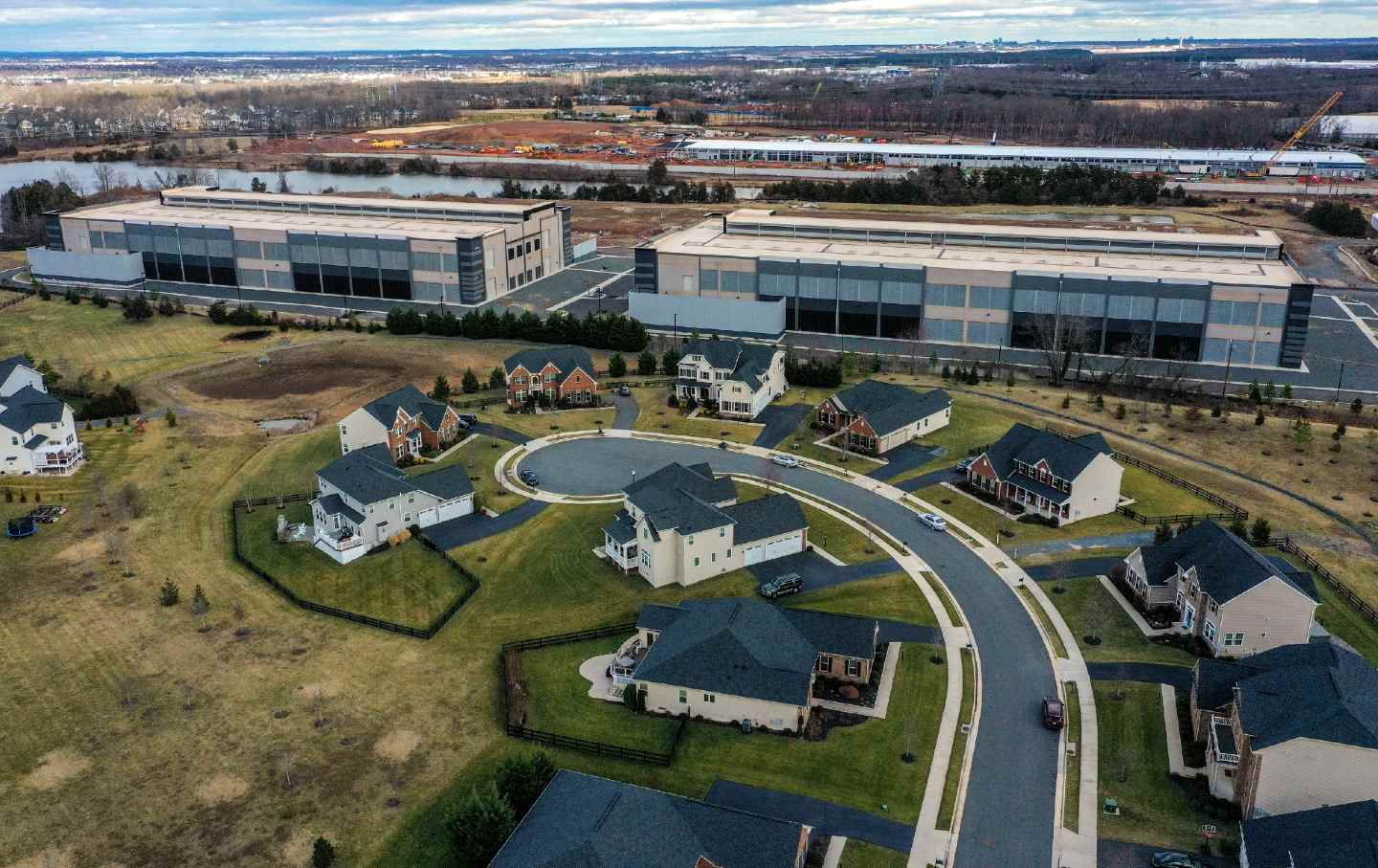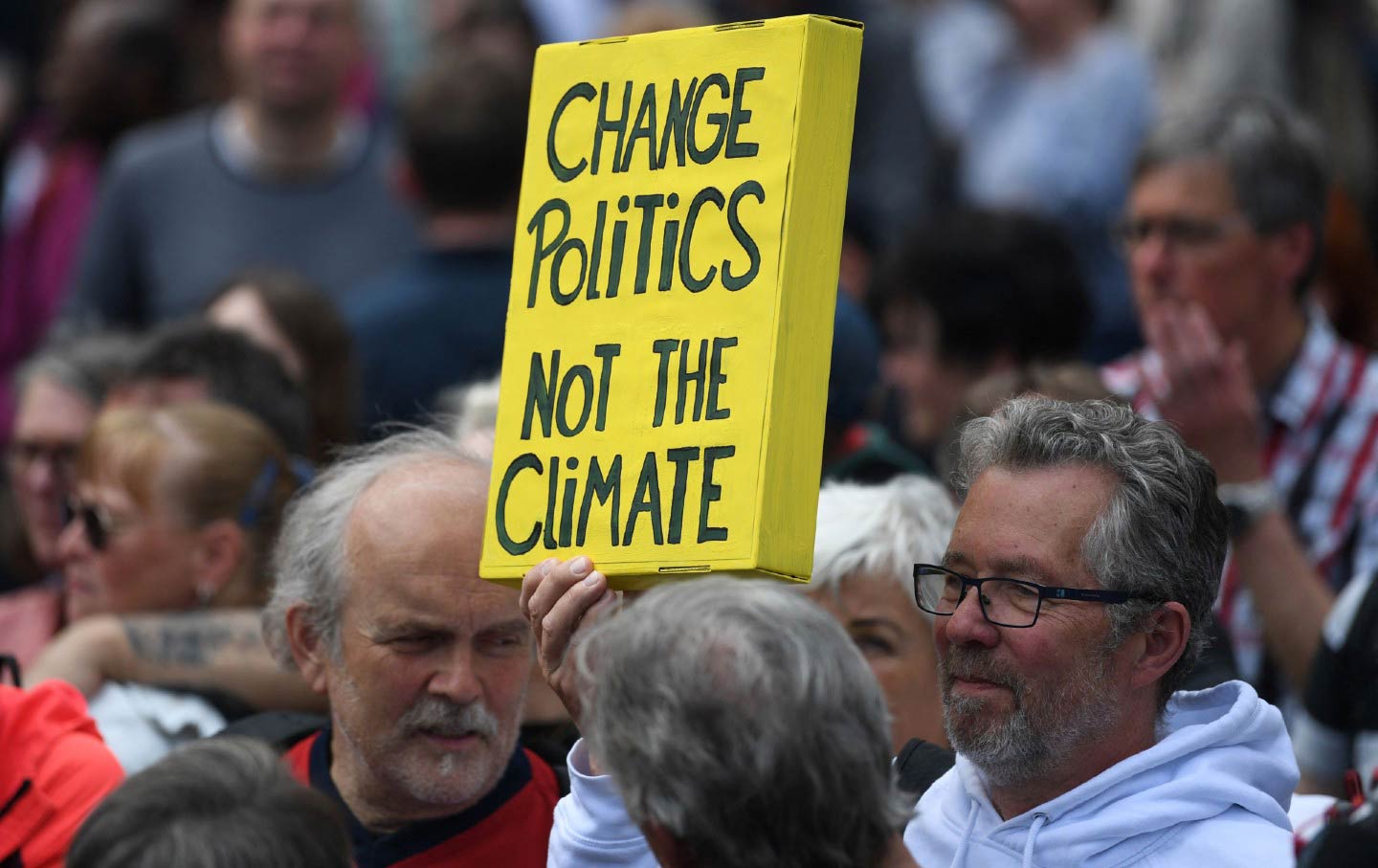The Dirty Energy Fueling Amazon’s Data Gold Rush
Northern Virginia is grappling with the environmental effects of a booming data-center empire.

Amazon data centers loom over houses at the edge of the Loudoun Meadows neighborhood on January 20, 2023, in Aldie, Va. Microsoft is in the process of building data-center structures in the background, top right.
(Jahi Chikwendiu / The Washington Post via Getty Images)Amazon doesn’t allow visitors to their data centers, but they offer a “virtual tour” of a generic facility. The website displays an aerial view of a digital mock-up of a building surrounded by farmland tinted a green too sickly to be bucolic. Miniaturized power lines, their cables like floss, curve around the building’s perimeter. Inside, neat rows of whirring servers form a layer cake of blinking lights and air conditioners. This 250,000-square-foot box of concrete, steel, and plastic is “the cloud”—where data from Internet activity ranging from consumer tracking to generative AI to the virtual tour itself is stored and processed.
This image of a building, of course, exists only in the cloud. But for the residents of northern Virginia’s Data Center Alley, “the cloud” is not some abstract omnipresence or a crisp virtual model; it is the hulking buildings powered by heavy transmission lines that criss-cross farmlands and ferry power generated by natural gas.
Northern Virginia has the largest concentration of data centers in the world, with over 25 million square feet in operation and much more in development. Amazon is one of the biggest players in the industry, having recently announced an additional $35 billion investment in Virginia, but companies like Google and Microsoft also have major hubs in the region. New facilities continue to crop up along the area’s Loudoun County Parkway. “When you’re driving down the street, it feels like there’s two walls on either side of you,” said Loudoun resident Julie Borneman. Her husband, Chris, agreed: “We’re turning into concrete out here.”
The energy demands of this data empire are massive. The power capacity used by data centers in the region was nearly 2.7 GW in 2022, more than Seattle’s entire power grid. A recent Business Insider investigation found that Amazon’s plans for expansion in the region could bring the company’s usage alone to at least 2.7 GW. Local environmental groups estimate that the total capacity needs for approved-but-unbuilt data centers amount to 23.4 GW, the equivalent of 5.8 million homes (more than the total number of households in the state). Based on regional energy operator PJM’s forecasting, that will contribute to a doubling of the area’s peak energy demand by 2040 and will require a state grid with the same capacity as France’s.
Capitalizing on the AI boom, Amazon and other companies are pushing through plans in Virginia for millions more square feet of data centers, which are being approved by municipalities faster than community groups and regulators can evaluate their impact. Electricity providers scrambling to meet industry demand are proposing new fossil fuel plants and to keep online coal plants that are due to be retired. Many of the costs of this infrastructure will be borne not by the data industry but by local communities, both through environmental impacts and their monthly utility bills.
How did northern Virginia, nearly 3,000 miles from Silicon Valley, become the hub of the data industry? Loudoun County, the municipality that hosts Data Center Alley, has made investment attractive for the industry by allowing by-right development, a fast-tracked permitting process. The state has also granted more than $980 million in tax exemptions to the data industry. “I have yet to see a data center with an end user like Amazon or Microsoft be denied anywhere in the state,” said Julie Bolthouse, the director of land use for the Piedmont Environmental Council, at a recent community meeting hosted by the group to discuss data-center growth.
Data centers contribute revenue through taxes on real estate and equipment. Loudoun County takes in nearly $600 million annually in data-center tax revenue, which covers the county’s entire operating budget. As Bolthouse told me, “That basically makes us a company town.”
In the last few years, the region has seen a data-center gold rush boosted by investors betting on the future of AI. Amazon operates or is in the process of planning and constructing 102 data centers in northern Virginia alone. “Investing in data centers is a way of ensuring that you have control over the entire infrastructures that are necessary to maintain AI,” said Tamara Kneese, a senior researcher at the Data & Society Research Institute.
Municipalities consider applications for each new data center individually—there is no state, regional, or federal requirement for them to track the cumulative impacts of dozens or even hundreds of new data centers coming online. The Virginia Data Center Reform Coalition, made up of more than 20 advocacy groups including the Piedmont Environmental Council, is urging the state to examine the snowballing effects of data-center development on the state’s electrical grid, water resources, air quality, and land-conservation efforts.
Once Amazon and other companies announce plans for new data centers, regional energy providers are required to meet that demand. In a 2023 proposal, regional power company Dominion said the increasing energy demand in the region was “driven primarily by data centers.” At the Piedmont community meeting, Bolthouse warned, “We’re basically going into an energy crisis if we continue to go in the direction we’re currently headed in Virginia.”
In order to meet this demand, energy operators are proposing unprecedented build-outs of energy infrastructure, including preserving and expanding fossil fuel generation. In its 2023 proposal, Dominion outlined several possible plans that could include up to seven new natural gas plants and delaying retirement of two coal-fired plants. The company also wants to build more high-voltage transmission lines and continue to invest in solar, wind, and energy storage development.
In January 2024, Dominion President Ed Baine said the company was embracing an “all-of-the-above energy mix,” echoing Republican Virginia Governor Glenn Youngkin’s plan to roll back clean-power legislation including the Virginia Clean Economy Act (VCEA). Dominion has publicly supported Governor Youngkin’s proposal to exit the Regional Greenhouse Gas Initiative, an effort with 11 neighboring states to limit carbon emissions from power plants. Victoria Higgins, the state director of the Chesapeake Climate Network, told me, “The fossil-fuel industry is on its way out. Dominion sees a political opportunity with Governor Youngkin and is squeezing the industry for the last couple dimes before we start to commit to renewables.” The investment blitz could lock the region into decades more of fossil-fuel production. According to Higgins, natural gas plants typically run for 30-40 years, which would put Dominion in violation of its commitments under the VCEA to achieve zero emissions by 2045.
In June 2023, Dominion announced that it was reviving plans for a new natural gas plant in Chesterfield, which was originally proposed in 2019 but abandoned after the passage of the VCEA. The plant would be one of the largest natural gas plants in the state, with a 1,000-MW capacity. Higgins estimated that the plant would emit 4.5 billion pounds of carbon dioxide per year even running just 37 percent of the time–the equivalent of 470,000 cars on the road. The proposed site is less than two miles from an elementary school and less than one mile from the nearest home, in an area that only recently saw a coal plant shuttered.
Dominion also plans to invest in new renewable energy infrastructure, including a major offshore wind project, an expansion of its solar fleet, and investments in battery storage. But Aaron Ruby, a spokesman for Dominion, said that a mix of renewables and fossil fuel sources would be necessary to serve data centers, which run around the clock. “While we’re all in on renewables, renewables alone cannot keep the power on 24/7, 365,” he said.
Still, some advocates like the Chesapeake Climate Network argue that Dominion can meet data center energy demands by focusing solely on clean energy generation. A report from the energy consulting firm Gabel Associates found that Dominion could meet peak demand projections by accelerating the retirement of fossil fuel plants, expanding solar adoption, and adding battery storage.
Popular
“swipe left below to view more authors”Swipe →In 2019 Amazon signed a Climate Pledge to reach net-zero emissions by 2040 after organizing and pressure from employees. In a statement, an Amazon Web Services spokesperson said, “Amazon is the world’s largest corporate purchaser of renewable energy, and we are on a path to procure 100% renewable energy by 2025.” Amazon purchases energy from solar and wind facilities through contracts with utilities known as power-purchase agreements. The energy Amazon buys flows onto the regional grid, not necessarily to the company’s data centers, but the contracts allow Amazon to include this clean energy in their emissions accounting.
Amazon has also said that part of their zero-emissions strategy involves the purchase of renewable-energy certificates (RECs), which allow companies to “match” a portion of their energy consumption by paying for renewable energy generation elsewhere. A recent study in Nature found that the use of RECs has led to an inflated estimate of corporate emissions mitigation efforts by allowing companies to report zero emissions regardless of the actual emissions produced by the electricity grid nearby (just 7 percent of Virginia’s grid is powered by renewables). If companies like Amazon are buying clean-energy credits, but rapidly increasing their own emissions, their dirty energy usage can still undermine climate goals. Amazon’s emissions pledge also does not speak to the air quality effects, water consumption, or other environmental impacts the facilities have over their service life.
Much of the energy used by data centers is dedicated to massive air conditioners that require a huge amount of water. According to Venkatesh Uddameri of Texas Tech University, a data center consumes up to 3 to 5 million gallons of water a day, the equivalent of a small city’s annual consumption. Bolthouse said that there isn’t a robust process for tracking the cumulative impact of water withdrawals of data centers. “That’s probably concerning to Fredericksburg, which is downstream [from proposed data-center campuses]. No one is asking them about pulling so much water.”
The costs of the energy infrastructure build-out will be passed on to everyday ratepayers through an additional rider on their monthly bill. According to an estimate by Dominion for the State Corporation Commission (SCC), a state economic regulator, the average household in the region could see their electric bill double by 2035. (Ruby, the Dominion rep, disputed the methodology used for the SCC estimate in an e-mail, saying the company’s internal forecasting estimates a 30 percent total increase in customers’ bills by 2035, lower than the historic rate of inflation.)
The data centers themselves are also ratepayers, but they get a bulk discount on their power. Chris Miller, the president of the Piedmont Environmental Council, told me, “They’re asking the average ratepayer in Virginia to subsidize the richest corporations in the world.”
Residents and environmental advocates are now trying to navigate the utility-regulation process at the local and state level. Dominion’s proposed measures to meet energy demand must be approved by the SCC, which appoints commissioners from a pool of experts who often have industry ties. Kelsey Bagot, a recently appointed commissioner, is also an attorney with NextEra energy, one of the companies proposing new transmission lines. (She has said she will recuse herself from decisions related to the company’s business.) Julie Borneman said she sees SCC approval as a rubber-stamp process. “The SCC hasn’t denied anything,” she said. “They’re down in Richmond, and they just look at northern Virginia as a profit center.”
Virginia’s state legislature is currently in session, and the Piedmont Environmental Council is pushing for a new regulatory framework that would put the burden of paying for this infrastructure onto the industry. Seventeen data center bills have been introduced this session dealing with energy efficiency, siting decisions, the permitting process, water consumption, and other issues.
In December 2023, the state passed a resolution to study the impacts of the data-center industry. Now, some lawmakers are using the pending study as an excuse to postpone legislation that would shift infrastructure costs to high-volume power users like data centers. Advocates say that the study is a good start, but regulation of the industry is needed now. Bolthouse says another year of delay will allow the industry to profit while communities suffer. “They know that this AI speculation boom is not going to last forever,” she said. “They want another year of the boom.”
Miller said he worried that Amazon and other industry leaders were working to shut down these measures. In Oregon, which hosts the second-largest concentration of data centers in the country, Amazon successfully fought off a bill that would have required new data centers to run entirely on clean energy sources by 2040. Dominion was among the top five donors to Virginia state candidates in 2023, giving over $11 million, while Amazon gave over $600,000.
Miller said Amazon wants “to keep the cost of expansion from being borne by them.” The question the state legislature should be asking, Miller said, is, “What are the royalties that should be paid by the global Internet industry to offset the impacts of their growth?”
Residents like Chris Borneman know what he’s owed: “Data centers need to be the ones paying for it,” he said. “We’re willing to pay a little bit extra for clean energy, but I’m not willing to fund their corporate bottom line.”
Hold the powerful to account by supporting The Nation
The chaos and cruelty of the Trump administration reaches new lows each week.
Trump’s catastrophic “Liberation Day” has wreaked havoc on the world economy and set up yet another constitutional crisis at home. Plainclothes officers continue to abduct university students off the streets. So-called “enemy aliens” are flown abroad to a mega prison against the orders of the courts. And Signalgate promises to be the first of many incompetence scandals that expose the brutal violence at the core of the American empire.
At a time when elite universities, powerful law firms, and influential media outlets are capitulating to Trump’s intimidation, The Nation is more determined than ever before to hold the powerful to account.
In just the last month, we’ve published reporting on how Trump outsources his mass deportation agenda to other countries, exposed the administration’s appeal to obscure laws to carry out its repressive agenda, and amplified the voices of brave student activists targeted by universities.
We also continue to tell the stories of those who fight back against Trump and Musk, whether on the streets in growing protest movements, in town halls across the country, or in critical state elections—like Wisconsin’s recent state Supreme Court race—that provide a model for resisting Trumpism and prove that Musk can’t buy our democracy.
This is the journalism that matters in 2025. But we can’t do this without you. As a reader-supported publication, we rely on the support of generous donors. Please, help make our essential independent journalism possible with a donation today.
In solidarity,
The Editors
The Nation








